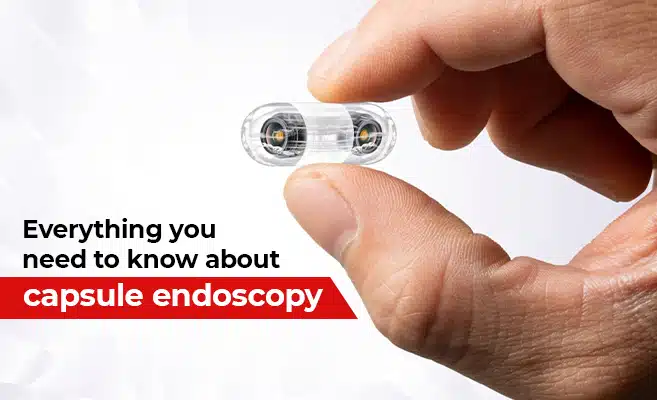Everything You Need to Know About Capsule Endoscopy

In simple terms, capsule endoscopy is a procedure performed via a small wireless camera to obtain images of your digestive system. To start the process, you are asked to swallow a multivitamin-sized capsule containing an endoscopic camera. The camera clicks thousands of photos, and then the wireless capsule endoscope passes through your digestive system.
Following, the images are sent to a recorder that you wear on a belt around your waist. When compared to more conventional endoscopic techniques, capsule endoscopy allows doctors to look within your small intestine, which is not always possible. In traditional endoscopy, a long, flexible tube with a video camera is inserted down the patient’s throat or via the rectum. Let’s find out more about capsule endoscopy below.
Why is Capsule Endoscopy Done?
A capsule endoscopy technique may be suggested by your doctor to:
- Determine what is causing the bleeding in your stomach. Examining unexplained bleeding in the small intestine is the most frequent cause of performing a capsule endoscopy.
- Recognise inflammatory bowel conditions like Crohn’s disease. An examination of the small intestine using a capsule can spot sites of inflammation.
- Identify cancer. The small intestine and other areas of the digestive tract may contain tumours, which can be seen during capsule endoscopy.
- Identify celiac illness. When determining the cause of this immunological response to consuming gluten, capsule endoscopy is occasionally used.
- Check the oesophagus. Additionally, oesophageal endoscopy using a capsule has been authorised for checking for unusual or enlarged veins in this muscle tube that joins your mouth to your stomach (varices).
- Look for polyps. Capsule endoscopy may occasionally be performed on people with hereditary disorders that might result in polyps in the small intestine.
- Following X-rays or other imaging examinations, schedule further testing. Your doctor could advise a capsule endoscopy if the findings of an imaging test are ambiguous or inconclusive.
How do You Get Ready for Capsule Endoscopy?
Food and medicines:
You will be requested to forgo eating and drinking at least 12 hours before the operation to aid the camera in getting clean photos of your digestive system. The small intestine may need to be flushed out before your capsule endoscopy in some circumstances, therefore your doctor may advise you to take a laxative. There is evidence to suggest that doing so enhances the quality of the images the capsule’s camera captures. Your doctor may advise against taking certain prescriptions before the surgery to prevent the medication from interfering with the camera.
Other safety measures
You’ll typically be able to get on with your day after swallowing the camera capsule. However, you probably won’t be allowed to lift or exercise vigorously. Inquire with your physician if you may resume work on the day of your capsule endoscopy if you have a demanding job.
Before the process
Your medical team will go through the process the day before your capsule endoscopy. So that adhesive patches may be applied to your belly, you might be requested to take off your shirt. An antenna and wiring that link to a recorder are included in each patch. The patches are not necessary for all devices. The recorder is worn around your waist on a specific belt. Your abdomen’s antenna patches receive images from the camera and transmit them to the recorder, which receives the information. Images are gathered by the recorder and kept there
Throughout the process
You take the camera capsule with water and drink it once the recorder is attached and ready. It is simpler to swallow when it has a slick covering. You shouldn’t be able to feel anything once you consume it. Then, you’ll carry on with your day. You can drive, and based on your employment, you could even be able to commute. Your doctor will also advise some precautions such as the need to refrain from engaging in vigorous exercise like running and leaping.
Following the procedure
After taking the pill, wait two hours before resuming clear liquid consumption. Unless your doctor instructs you differently, you are allowed to have a small lunch or a snack after four hours. After eight hours or when you see the camera capsule in the toilet following a bowel movement, whichever occurs first, the capsule endoscopy treatment is over. Put the recorder and patches in a bag, take them off your body, and then follow your doctor’s instructions for returning the equipment. The camera capsule may be flushed into the toilet.
Your body may remove the camera capsule within hours or take many days to do so once the treatment is complete. The digestive system varies from person to person. Within two weeks, call your doctor if you still haven’t found the capsule in the bathroom. To check if the capsule is still inside of you, your doctor could ask for an X-ray.
Conclusion
Thousands of colour photographs are taken while the endoscopic capsule camera travels through your digestive system. Using the video, your doctor checks for any irregularities in your digestive system. You can be confident that PSRI Hospital will go above and beyond to provide you with the best treatment options while guaranteeing a safe and worthwhile experience.

 Book An Appointment
Book An Appointment Virtual Consultation
Virtual Consultation




